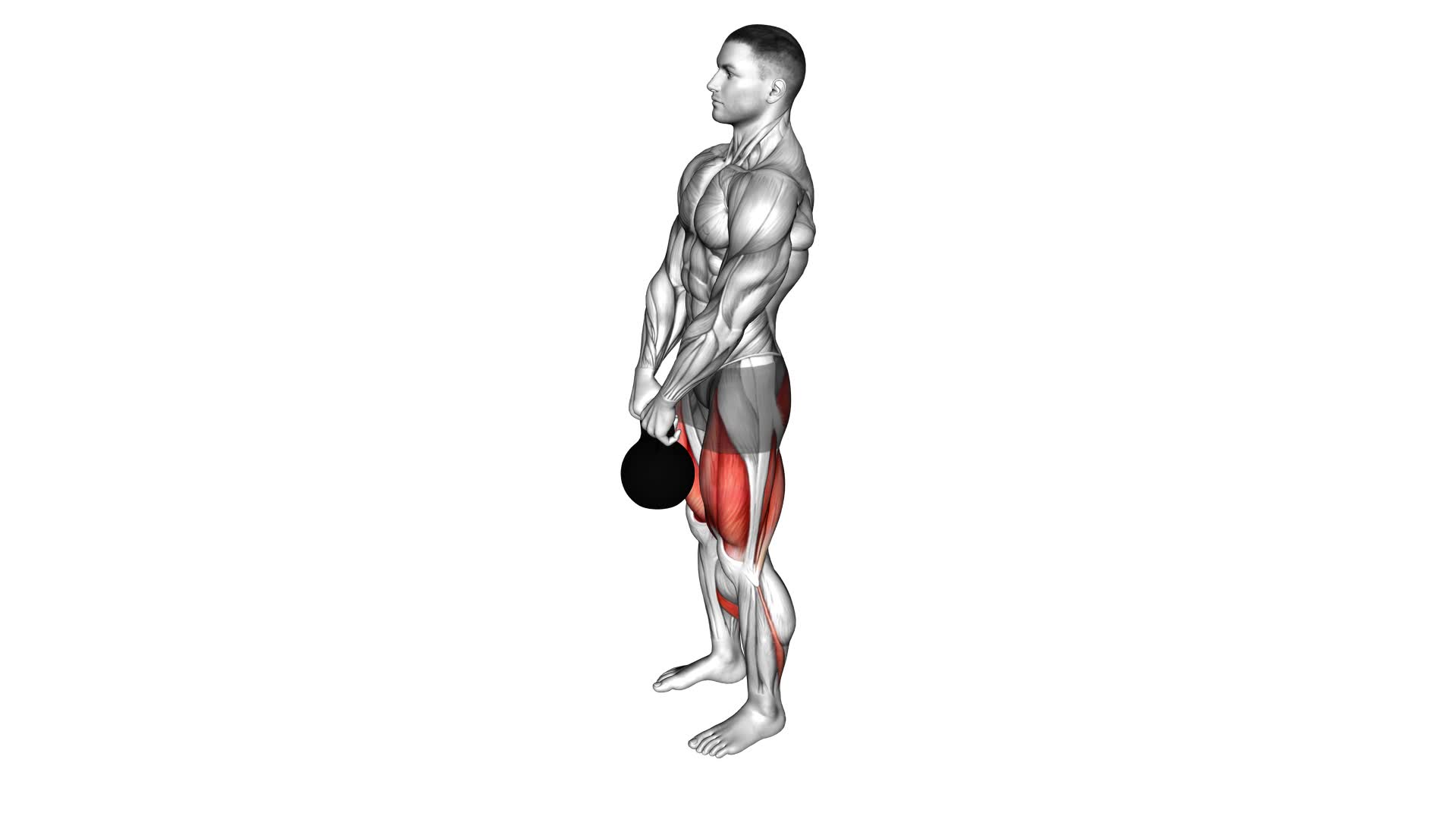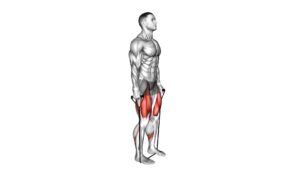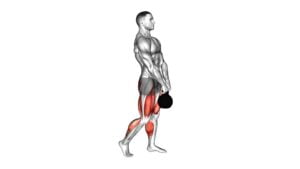Kettlebell Straight Leg Deadlift – Video Exercise Guide & Tips

Ready to take your fitness routine to the next level? Look no further than the kettlebell straight leg deadlift.
Watch This Exercise Video
This powerful exercise targets your hamstrings, glutes, and lower back, giving you a strong and sculpted lower body.
In this video exercise guide, you'll learn the proper form and technique to ensure maximum results. With helpful tips and variations, you'll be able to customize your workout and challenge yourself.
Get ready to sweat and see those gains!
Key Takeaways
- Targets hamstrings, glutes, and lower back
- Improves overall strength and stability
- Strengthens posterior chain for improved posture and reduced lower back pain
- Engages core for a strong and stable midsection
Benefits of Kettlebell Straight Leg Deadlifts
To maximize your workout, incorporate Kettlebell Straight Leg Deadlifts for their numerous benefits.
This exercise not only targets your hamstrings, glutes, and lower back, but also helps in maximizing results by improving your overall strength and stability.
One of the key benefits of Kettlebell Straight Leg Deadlifts is that it strengthens your posterior chain, which includes the muscles in your back, glutes, and hamstrings. By targeting these muscles, you can improve your posture and reduce the risk of lower back pain.
Additionally, this exercise engages your core, helping you develop a strong and stable midsection.
The Kettlebell Straight Leg Deadlift also enhances your hip mobility, as it requires a wide range of motion. This can be particularly beneficial for athletes and individuals performing activities that involve hip extension, such as running or jumping.
By incorporating Kettlebell Straight Leg Deadlifts into your workout routine, you can enjoy the benefits of increased strength, improved posture, reduced lower back pain, and enhanced hip mobility.
Now, let's move on to the next section and discuss the proper form and technique for performing this exercise.
Proper Form and Technique
To perform the kettlebell straight leg deadlift with proper form and technique, there are a few key points to keep in mind.
First, focus on a correct hip hinge movement, keeping your back straight and allowing your hips to move back and down.
Second, avoid rounding your back throughout the movement to prevent strain or injury.
Lastly, engage your glutes and hamstrings as you lift the kettlebell, ensuring that the movement is driven by these muscles rather than your lower back.
Correct Hip Hinge
Mastering the correct hip hinge is essential for performing the kettlebell straight leg deadlift with proper form and technique. The hip hinge is a fundamental movement pattern that involves hinging at the hips while keeping a neutral spine.
It's important because it allows you to engage the glutes and hamstrings while minimizing stress on the lower back. By improving hip mobility and preventing lower back pain, the correct hip hinge ensures that you're able to maintain a strong and stable position throughout the exercise.
To execute the hip hinge correctly, imagine pushing your hips back as if you were closing a car door with your glutes. This will help you maintain a straight back and avoid rounded shoulders, as we'll discuss in the next section.
Avoid Rounded Back
When performing the kettlebell straight leg deadlift, it's crucial to avoid rounding your back in order to maintain proper form and technique. A rounded back puts unnecessary stress on your spine and can increase the risk of injury, particularly to your lower back.
To prevent rounding, focus on keeping your core engaged and your spine in a neutral position throughout the movement. Imagine a straight line running from your head to your hips. Keep your shoulders pulled back and down, and your chest lifted.
It may also be helpful to start with a lighter weight until you can perform the exercise with proper form. Prioritizing a flat back won't only enhance your performance but also aid in injury prevention.
Engage Glutes and Hamstrings
To properly engage your glutes and hamstrings during the kettlebell straight leg deadlift, focus on driving through your heels as you lift the kettlebell. Here are four key points to help you maximize results and progress to advanced variations:
- Start with a light kettlebell and gradually increase the weight as your strength improves.
- Keep your back straight and core engaged throughout the movement to maintain proper form and prevent injury.
- As you hinge at the hips, imagine pushing your glutes backward while maintaining a slight bend in the knees.
- Squeeze your glutes at the top of the movement to fully engage the muscles and increase the effectiveness of the exercise.
Choosing the Right Kettlebell Weight
Start by selecting a kettlebell weight that challenges you but allows you to maintain proper form throughout the exercise. Determining the appropriate intensity is crucial to avoid injury and maximize the effectiveness of the kettlebell straight leg deadlift. Choosing a weight that's too light may not provide enough resistance to engage your muscles effectively, while selecting a weight that's too heavy can lead to compromised form and potential injury.
To determine the right kettlebell weight for you, consider your current strength and fitness level. Start with a lighter weight initially and gradually increase the weight as you become more comfortable and confident with the movement. It's essential to feel a moderate level of resistance during the exercise without sacrificing your form.
Additionally, pay attention to your body's feedback. If you experience pain or discomfort during the exercise, it may be an indication that the weight is too heavy or that your form needs improvement. Listen to your body and make adjustments accordingly.
Common Mistakes to Avoid
To ensure proper form and avoid potential injury, it's important to be aware of common mistakes that you should avoid when performing the kettlebell straight leg deadlift. Here are four common mistakes to watch out for:
- Rounding your back: One of the most common mistakes is rounding your back during the movement. This puts unnecessary stress on your spine and increases the risk of injury. Keep your back straight and engage your core throughout the exercise.
- Using too heavy of a kettlebell: Choosing a kettlebell that's too heavy can lead to improper form and put excessive strain on your lower back. Start with a lighter kettlebell and gradually increase the weight as you become more comfortable with the exercise.
- Bending your knees too much: The kettlebell straight leg deadlift is meant to target your hamstrings and glutes, so it's important to keep your legs relatively straight. Avoid bending your knees too much, as this shifts the focus away from the intended muscle groups.
- Lifting the kettlebell too high: When performing the straight leg deadlift, the kettlebell shouldn't be lifted higher than your thighs. Lifting it too high can cause your back to round and increase the risk of injury. Keep the movement controlled and within a comfortable range of motion.
Variations and Progressions
Now that you have mastered the basic kettlebell straight leg deadlift, it's time to explore advanced progressions for added variety and challenge.
These variations can help you continue to improve your technique and adapt your workout to your specific goals.
Advanced Progressions for Variety
Take your kettlebell straight leg deadlifts to the next level with advanced progressions for added variety and challenge. Here are four advanced modifications and programming options to keep your workouts fresh and push your limits:
- Single-leg kettlebell straight leg deadlift: Perform the exercise with one leg while keeping the other leg lifted off the ground. This variation increases the demand on your balance and stability.
- Kettlebell deficit straight leg deadlift: Stand on a raised platform or step, allowing for a greater range of motion. This variation targets your hamstrings and glutes even more intensely.
- Kettlebell swing to straight leg deadlift: Combine the explosive hip hinge movement of the kettlebell swing with the controlled lowering of the straight leg deadlift. This dynamic exercise challenges your posterior chain and improves power.
- Kettlebell suitcase deadlift: Hold a kettlebell in each hand, maintaining a neutral grip. This variation places a greater demand on your core and grip strength.
Incorporating these advanced progressions will add variety and intensity to your kettlebell straight leg deadlifts, helping you achieve your fitness goals faster.
Technique Variations for Adaptation
Continue exploring the topic of 'Technique Variations for Adaptation (Variations and Progressions)' by incorporating these advanced progressions into your kettlebell straight leg deadlifts.
When it comes to adapting exercises to suit your fitness level or specific needs, there are several adaptation techniques you can use. One technique is to modify the range of motion by starting with a shorter range and gradually increasing it as you become more comfortable and stronger.
Another technique is to adjust the load by using a lighter or heavier kettlebell. You can also modify the exercise by changing the tempo, such as performing the movement at a slower or faster pace.
Additionally, you can try performing the exercise on an unstable surface, like a balance board, to challenge your core stability and improve overall body control.
Tips for Maximizing Results
To maximize your results with the Kettlebell Straight Leg Deadlift, try incorporating these tips:
- Focus on form: Maintaining proper form is crucial for maximizing gains and preventing injuries. Keep your back straight, engage your core, and hinge at the hips while lowering the kettlebell.
- Start with lighter weights: It's important to gradually increase the weight as you progress. Begin with a lighter kettlebell to ensure proper technique and reduce the risk of injury. As your strength improves, you can gradually increase the weight.
- Control the movement: Slow and controlled movements are key to maximizing the benefits of the exercise. Avoid using momentum to lift the kettlebell and instead focus on engaging your muscles throughout the entire range of motion.
- Incorporate variations: To challenge your muscles in different ways and prevent plateauing, consider incorporating variations of the Kettlebell Straight Leg Deadlift. This can include using a single leg, adding a twist, or performing the exercise on an unstable surface.
Frequently Asked Questions
What Are Some Alternative Exercises That Can Target Similar Muscle Groups as the Kettlebell Straight Leg Deadlift?
If you're looking for alternative exercises to target similar muscle groups as the kettlebell straight leg deadlift, there are a few options you can try.
Variations of the deadlift exercise, such as the barbell deadlift or the dumbbell Romanian deadlift, can be effective alternatives. These exercises also focus on the posterior chain muscles, including the glutes and hamstrings, helping to improve strength and stability in your lower body.
Make sure to use proper form and start with lighter weights before progressing to heavier loads.
Can Kettlebell Straight Leg Deadlifts Be Performed by Beginners?
Yes, beginners can perform kettlebell straight leg deadlifts.
It's important to learn the proper form and technique to avoid common mistakes.
Keep your back straight, engage your core, and hinge at the hips while maintaining a slight bend in your knees.
Avoid rounding your back or using your lower back to lift the kettlebell.
Start with lighter weights and gradually increase as you build strength and confidence.
How Often Should Kettlebell Straight Leg Deadlifts Be Incorporated Into a Workout Routine?
To get the most out of your workout routine, it's important to consider the incorporation frequency of kettlebell straight leg deadlifts. By including this exercise regularly, you can experience the benefits of improved strength in your glutes, hamstrings, and lower back.
Additionally, varying your kettlebell weight and foot positioning can provide different challenges and target different muscle groups. So, make sure to add kettlebell straight leg deadlifts to your routine for optimal results.
Are There Any Precautions or Modifications That Should Be Taken for Individuals With Pre-Existing Back or Knee Injuries?
When dealing with pre-existing back or knee injuries, it's crucial to take precautions and make modifications when performing kettlebell straight leg deadlifts. Safety should be your top priority.
To protect your back, try reducing the weight or using a smaller kettlebell.
For knee injuries, consider adjusting your stance or using a pad for extra support.
Always listen to your body and consult with a professional if needed.
Stay safe and avoid aggravating any existing injuries.
Can Kettlebell Straight Leg Deadlifts Help Improve Flexibility in Addition to Strength?
Improving flexibility with kettlebell straight leg deadlifts can be beneficial for your overall workout routine. By incorporating this exercise into your routine, you can work on both strength and flexibility.
Kettlebell straight leg deadlifts target your hamstrings, glutes, and lower back, helping to increase their range of motion. This can lead to improved flexibility over time.
Conclusion
In conclusion, the kettlebell straight leg deadlift is a highly effective exercise for strengthening the posterior chain and improving overall lower body strength. By maintaining proper form and technique, choosing the right kettlebell weight, and avoiding common mistakes, you can maximize the benefits of this exercise.
Additionally, incorporating variations and progressions can help to continually challenge your muscles and promote further growth. Follow these tips to achieve optimal results and enhance your fitness journey.

Author
Years ago, the spark of my life’s passion ignited in my mind the moment I stepped into the local gym for the first time. The inaugural bead of perspiration, the initial endeavor, the very first surge of endorphins, and a sense of pride that washed over me post-workout marked the beginning of my deep-seated interest in strength sports, fitness, and sports nutrition. This very curiosity blossomed rapidly into a profound fascination, propelling me to earn a Master’s degree in Physical Education from the Academy of Physical Education in Krakow, followed by a Sports Manager diploma from the Jagiellonian University. My journey of growth led me to gain more specialized qualifications, such as being a certified personal trainer with a focus on sports dietetics, a lifeguard, and an instructor for wellness and corrective gymnastics. Theoretical knowledge paired seamlessly with practical experience, reinforcing my belief that the transformation of individuals under my guidance was also a reflection of my personal growth. This belief holds true even today. Each day, I strive to push the boundaries and explore new realms. These realms gently elevate me to greater heights. The unique combination of passion for my field and the continuous quest for growth fuels my drive to break new ground.







